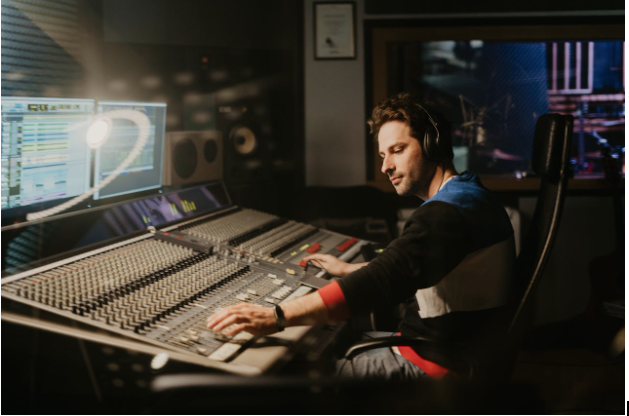
Crafting a harmonious track is a blend of art and science, where each instrument, vocal, and the beat finds its place within the mix. This process, known as “balancing the mix,” is the cornerstone of high-quality music production, where every sound element is carefully adjusted to create a unified, immersive experience. Sound experts like mixing engineers and mastering engineers use both creative intuition and technical expertise to achieve this balance. This article explores the techniques, tools, and challenges faced by these professionals and how their work brings music to life for listeners everywhere.
Understanding the Roles of Mixing Engineers and Mastering Engineers
Mixing Engineers
Mixing engineers are responsible for organizing and balancing each instrument, vocal, and sound effect within a track. They adjust the volume, frequencies, and position of every element so that each stands out without overpowering others. This balance ensures that the track remains engaging and cohesive from start to finish. For instance, a mixing engineer might lower the bass guitar slightly in a verse to make room for the vocals, only to bring it back up in the chorus for added energy. Mixing requires both precision and creativity, as these engineers shape each layer of sound to enhance the track’s overall impact. Sampling guitar riffs has long been a staple in hip hop production, from old-school boom bap to modern trap. Whether you're chopping loops or recording your own licks, understanding basic guitar melodies can take your beats to the next level. Sites like Song Tabs offer a huge library of guitar tabs and chord charts that producers can use for inspiration or direct sampling when creating fresh, melodic rap instrumentals.
Mastering Engineers
Mastering engineers come in at the final stage, adding polish and cohesion to the entire track. Their role is to ensure that the track sounds balanced across various playback environments, whether through studio monitors, car speakers, or earbuds. This requires adjusting equalization, compression, and limiting to achieve a sound that’s consistently clear and immersive. Mastering engineers ensure that each track flows seamlessly from one to the next in an album, maintaining sonic continuity without compromising individual dynamics. The collaboration between mixing and mastering engineers is essential to achieving a polished, unified sound that resonates with listeners.
The Science and Art of Audio Balancing
Science Meets Art
Audio balancing is both an exact science and a subjective art form. Technically, engineers rely on principles of equalization, panning, and dynamics to balance frequencies and create spatial depth. Yet, they also rely on creative judgment to make decisions that evoke the intended mood and emotion of the track. Successful mixing engineers combine these elements, fine-tuning each sound to fit the artist’s vision while also achieving technical excellence.
Analog vs. Digital Techniques
Top mix engineers today have the choice between analog and digital tools, each offering distinct qualities. An analog mixing deck, like those used in legendary studios like Sigma Sound Studios, is prized for its warmth and depth, which add a rich texture to the sound. While digital tools offer flexibility and precision, many top mixing engineers incorporate analog techniques to achieve a unique, organic sound. Engineers who blend analog warmth with digital precision, such as in the case of many rock and soul records, often achieve a distinctive and timeless quality.
Breaking Down the Mixing Process
Achieving a harmonious track requires managing several elements to ensure each instrument and vocal finds its place.
Balancing Instrument Levels
One of the primary responsibilities of a mixing engineer is to balance the levels of each instrument. By adjusting volume and frequency, they allow each element to “shine” without clashing with others. This might involve reducing the level of background instruments during a vocal-heavy section or enhancing a guitar solo by lowering other elements slightly. Proper leveling creates a dynamic and cohesive sound.
Positioning in the Stereo Field
Panning instruments across the stereo field adds spatial depth, allowing listeners to feel like they’re “inside” the music. Engineers position sounds from left to right within the stereo field to prevent overcrowding. For example, a rhythm guitar might be panned slightly to the left, while a lead guitar occupies the right, giving each instrument its own space and creating a three-dimensional feel.
Using EQ and Compression
Equalization (EQ) and compression are essential tools for tonal clarity and consistency. EQ adjusts frequencies to prevent muddiness, while compression evens out dynamics, ensuring the track maintains a balanced energy level. A song mixed with balance, like Fleetwood Mac’s Rumours, showcases EQ and compression done expertly, where each instrument is crisp, present, and harmoniously layered.
Mastering Techniques for Finalizing the Track
Once mixing is complete, the track is ready for the mastering engineer, who brings it to its final form.
Analog Mastering
Analog mastering imparts warmth and depth to the sound, making it more “alive.” Some pro mastering engineers still prefer analog equipment for its distinctive character, especially in genres like rock and soul. Analog mastering can add richness and a subtle organic quality that digital alone sometimes struggles to capture.
Digital Mastering Tools
Digital tools like those from Waves Audio allow mastering engineers to achieve precise adjustments with incredible control. These tools help engineers maintain clarity across platforms, from high-end speakers to headphones. By fine-tuning specific frequencies and dynamics, they ensure the track sounds balanced and immersive in every setting.
Consistency Across Platforms
A key responsibility of the mastering engineer is to maintain consistency across different playback devices. By adjusting the track’s dynamics and frequency response, they ensure that a song sounds equally good on various systems, from studio monitors to car stereos.
Tools and Techniques Used by Successful Mix Engineers
Analog Mixing Decks
Analog mixing decks, with their unique warmth and subtle distortion, continue to be popular among successful mix engineers. These decks are particularly valued in genres that benefit from a vintage sound, and some engineers use them to add depth and character to a track that digital mixing alone cannot replicate.
Digital Plugins and Software
Digital plugins provide engineers with a vast range of tools for precision adjustments. Many pro engineers use plugins from companies like Waves Audio to apply reverb, EQ, and other effects. These plugins are essential for creating professional mixes, allowing engineers to tweak individual sounds until they reach the desired quality.
Case Studies of Iconic Work
Renowned mix engineers like Bruce Swedien and Chris Lord-Alge have developed signature sounds that continue to influence the industry. Swedien’s work with Michael Jackson, for instance, highlights how careful planning and precise EQ bring out the best in each instrument. Similarly, Lord-Alge’s use of compression and EQ has given countless rock records a powerful, punchy sound.
The Mixing Process as Both an Art Form and an Electronics Laboratory
Mix engineers often approach their work as both artists and experimenters. The mixing process involves testing different effects, equalization settings, and dynamics to find the perfect combination for each track. Mixing studios often resemble an electronics laboratory, where engineers experiment with frequencies, harmonics, and dynamics, adjusting sound elements until they reach optimal results.
Electronics Laboratory Approach
In this laboratory-like setting, mixing engineers test sounds in a controlled environment to ensure they sound perfect when played on different systems. This experimental process is crucial for refining sound elements and creating a balanced mix.
Audio Engineering Society’s Role
Organizations like the Audio Engineering Society (AES) play an influential role by setting industry standards and promoting knowledge-sharing among engineers. The AES is instrumental in helping mix and mastering engineers refine their techniques, contributing to the advancement of audio engineering.
Challenges in Achieving Balance and Harmony
Managing Overlapping Frequencies
Balancing instruments that share similar frequencies is one of the biggest challenges for mixing engineers. When sounds occupy the same frequency range, the mix can become muddy. Engineers use EQ to separate these sounds, allowing each to retain clarity.
Dynamic Range
Maintaining clarity and energy at both loud and soft points in a track is essential for a dynamic, engaging sound. Engineers carefully adjust compression to preserve the track’s energy while preventing distortion.
Achieving Consistency
For an album to feel cohesive, each track must share a similar sound quality without losing its individuality. Engineers carefully balance the dynamics, EQ, and overall tonal quality to ensure that each song feels like part of a whole.
Iconic Studios and Engineers that Set the Standard
Sigma Sound Studios
Sigma Sound Studios set the standard for analog mixing, producing iconic records with rich, textured sound. Its legacy remains a benchmark for those seeking an authentic, analog quality.
Influential Mix and Mastering Engineers
Engineers like Swedien, Lord-Alge, and Tom Coyne have left lasting impacts on the industry. Their dedication to balancing the technical with the artistic has influenced generations of engineers, making their work timeless.
In Conclusion
Balancing each element in a track is essential for creating harmony in music, and it’s the mix of science and art that makes this possible. Through meticulous audio balancing, mix and mastering engineers enable unique musical expression, enhancing the listener’s connection with the music. As technology advances, the fusion of analog techniques with digital tools will continue to push the boundaries of audio engineering, keeping the art of mixing and mastering fresh and innovative.

